




We have locations all over San Diego! Scripps Ranch (Chabad S. Diego HQ), Bonita, Carlsbad North, Carmel Valley, Coronado, Downtown, East County, Encinitas, Escondido, La Costa, La Jolla, North County Inland, Oceanside/Vista, Pacific Beach, Penasquitos, Rancho S. Fe, SDSU, Tierra Santa, UCSD, University City
JEWISH IDENTITY AND LEADERSHIP
EXPERIENTIAL




Connecting with Israel & global Jewish peoplehood Ensuring a vibrant Jewish future
Building a resilient & secure Jewish community Caring for Jews in need

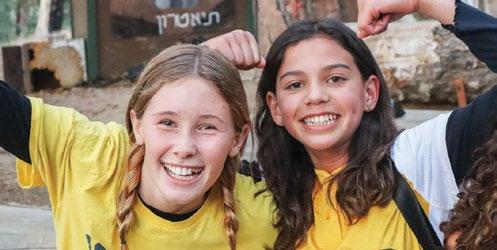


This is Federation.
For nearly 90 years, Jewish Federation has worked to ensure there will be a vibrant, caring, connected, and enduring Jewish community in San Diego, Israel, and around the world for generations to come. Your support is not just a donation; it is an investment in a thriving Jewish future.
To learn more or make a gift, visit jewishinsandiego.org.



PUBLISHERS
Mark Edelstein and Dr. Mark Moss
EDITOR
Susan Edelstein
ASSISTANT EDITOR
Makayla Hoppe
ARTS & ENTERTAINMENT EDITOR
Eileen Sondak
CREATIVE DIRECTOR
Donna D’Angelo
SENIOR CONSULTANT
Ronnie Weisberg
CONTRIBUTING WRITERS
Emily Bartell, Linda Bennett, Leorah Gavidor, Emily Gould, Patricia Goldblatt, Sharon Rosen Leib, Andrea Simantov, Marnie Macauley, Lisa McGuigan, Rabbi Jacob Rupp, Rachel Eden, T.S. McNeil, Sybil Kaplan.
ADVERTISING REPRESENTATIVES Alan Moss | Palm Springs
EDITORIAL
editor@sdjewishjournal.com
ADVERTISING marke@sdjewishjournal.com
CIRCULATION & SUBSCRIPTIONS ronniew@sdjewishjournal.com
ART DEPARTMENT art@sdjewishjournal.com
LISTINGS & CALENDAR assistant@sdjewishjournal.com
SDJJ is published monthly by San Diego Jewish Journal, LLC. Subscription rate is $24 for one year (12 issues). Send subscription requests to SDJJ, 7742 Herschel Ave., Suite H, La Jolla, CA 92037. The San Diego Jewish Journal is a free and open forum for the expression of opinions. The opinions expressed herein are solely the opinion of the author and in no way reflect the opinions of the publishers, staff or advertisers. The San Diego Jewish Journal is not responsible for the accuracy of any and all information within advertisements. The San Diego Jewish Journal reserves the right to edit all submitted materials, including press releases, letters to the editor, articles and calendar listings for brevity and clarity. The Journal is not legally responsible for the accuracy of calendar or directory listings, nor is it responsible for possible postponements, cancellations or changes in venue. Manuscripts, letters, documents and photographs sent to the Journal become the physical property of the publication, which is not responsible for the return or loss of such material. All contents ©2024 by San Diego Jewish Journal. The San Diego Jewish Journal is a member of the American Jewish Press Association and the Jewish Telegraphic Agency.
San Diego Jewish Journal (858) 638-9818 | fax: (858) 263-4310
#SDJewishJournal SanDiegoJewishJournal sdjewishjournal.com







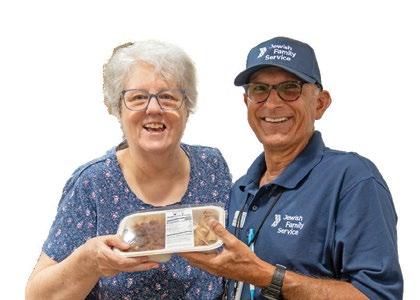










The Music of Sergei V. Rachmaninoff
Book by Hershey Felder Directed by Trevor Hay
Hershey Felder’s newest musical play will feature him in the role of composer and pianist Sergei Rachmaninoff alongside British-Italian actor Jonathan Silvestri in the role of Tsar Nicholas II. Having safely left Russia during the 1917 revolution, Rachmaninoff eventually made his home in Beverly Hills, but always longed for the Tsarist Russia that he knew and loved as a young man. Featuring Rachmaninoff’s most beloved compositions, this promises to be another mystical musical journey in the Hershey Felder style that patrons have come to know and love.
Don’t Miss The World Premiere Production!


SUSAN EDELSTEIN
Summer has finally hit the coast, but as August dawns and the season begins to wane, the thoughts of many turn to school and what the coming year might bring. School has changed dramatically and irrevocably since the advent of Google Classroom in ways many of us don’t quite understand. This is so in kindergarten through high school, and some of what is happening in our universities is incomprehensible. We need to take a step back, take a deep breath, and realize people need to learn how to think, how to dream and how to imagine what could be. Sometimes, we don’t even know for sure what we think, we just espouse the thinking of someone else we admire or look up to at that moment instead of taking the time to think more about it. Schools could teach thinking. It is a skill, one that seems to function beautifully in the preliterate group, but one that needs to be taught once school sets in. This could be demonstrated by anyone and practiced by everyone. Good thinking skills take time and guidance — gentle guidance. Young people need a sense of safety and calmness to look inward and explore the workings of thought and emotion and learn the wonder of their own brains. We have the right to dream; we just need to nurture it. How we should treat the preciousness of children’s innermost selves was said best by Langston Hughes:
The Dream Keeper
Bring me all of your dreams,
You dreamers.
Bring me all of your
Heart melodies
That I may wrap them
In a blue cloud-cloth
Away from the too rough fingers
Of the world.
In this issue, there are lots of ways to learn and to teach. The inimitable Hershey Felder teaches us about the world’s most beautiful music and its composers through his self-created solo performances and recordings. Both Ben Cole and Teralta Art operate in a Langston Hughes-esque manner to bring out the best in people. Marnie Macauley calls for a revolution in education; Lisa McGuigan is spreading the word about Little Free Libraries spreading the word; and Trevor McNeil reminds us of the power and impact of women’s voices. As usual, Rabbi Eilfort is pushing us to think, and we are grateful for the lessons from Israel from Andrea Simantov and Galia Sprung. Congratulations to the two new heads of school at San Diego Jewish Academy and San Diego Hebrew Day School, always at the forefront of education. A
by Linda Bennett and Emily Bartell

The 31st Annual Lipinsky Family San Diego Jewish Arts Festival, “JFEST 2024,” was a highly entertaining and successful event, offering extraordinary programming at a variety of locations throughout San Diego. Every year, we find ourselves with a surprising selection of choice programming at this annual event. We enjoyed so many of the “JFEST 2024” selections this year. However, there were two events that truly stood out:
The first was “The 15th Annual Women of Valor,” honoring the lives of San Diego area Jewish women through words, music and images. This year’s honorees were Sara Brown, Debbie Kornberg, Vered Libstein, Rabbi Devorah Marcus, Bev Pamensky and Dr. Barbara Parker. This year, an exception to the rule was made for Vered Libstein who is from the Shar Ha-Negav. The whole audience was brought to tears when her story was voiced to the crowd.
The second was “Mandy Patinkin in Concert: Being Alive,” which was a rare treat. Acclaimed actor, singer and storyteller Mandy Patinkin passionately performed a collection of his favorite Broadway and classic American songs from Irving Berlin, Stephen Sondheim, Cole Porter, Harry Chapin and more.
At the many different programs we attended, some of those we ran into were Becca Bierman and Patrick Lester, Paula Taylor and Bernie Kulchin, Amy Krause and Paul Needelman, Lydia and Ron Krasner, Amy and Chuck Spielman, Rochelle and Paul Treger, Jane and Colin Scher, Perla and Jeff Myers, Roberta and Norman Greene, Ella Cashuk, Joey Landwehr, Harriet
Kader, Irwin Jacobs, Sheila Lipinsky, Lori Shearer and Brian Haubenstock, and Judi Gottchalk
On June 8, Congregation Beth Israel held its annual fundraiser, “L’chaim to Life.” This year, the congregation honored Lee and Frank (z”l) Goldberg with the Carl M. Esenoff Memorial Award in recognition of their service to the Jewish and general communities of San Diego. The Goldbergs have been dedicated members of the congregation since 1967, with many generations of the Goldberg family following in their footsteps, exemplifying true l’dor v’dor from generation to generation.
Some of those on hand enjoying the evening’s celebration with us were Silvana and Richard Christy, Lynn Epsten, Esther Fischer, Elaine Galinson and Herb Solomon, Sylvia and David Geffen, Cindy and Wayne Schwarz, Barbara and Rick Cohen, Lisa and Carl Measer, Robin Sassi and Larry Katz, Marsha Lubick, Paul Nestor, Emily and Chris Jennewein, Sandra Levinson, Miriam Norten and Alex Stolarski, Barb and Mo Winicki, and many others.
Mazel Tov to Sharon Abada and Eric Wittgrove on their marriage on June 23 at Temple EmanuEl by Rabbi Marty Lawson. Proud parents, Perri Wittgrove, Alan Wittgrove, and Laura and David Abada of Sunnyvale, CA, looked on with pride.
Mazel Tov to Star Laddon as she embarks on a welldeserved retirement after 20 years of exceptional and devoted service as Temple EmanuEl’s Torah School Administrator. She will truly be missed by the whole congregation.
Mazel Tov to Samantha and Jared Luchans on their son, Jack Philip, becoming a Bar Mitzvah at Temple EmanuEl on June 8. The ceremony was officiated by Rabbi Benj Fried. Grandparents, Mebys Abrams and Renee and Harvey Luchans along with Jack’s siblings, Keira and Aidan, looked on with pride. Late Grandfather was Jack Abrams (z”l)
Mazel Tov to Michelle and Charlie Jirkovsky on the birth of their daughter, Melody Charlotte. Melody’s Grandparents are Claire and Natalie Fritz
Morris Gold celebrating his 93rd birthday.
Brice Westphall celebrating his 84th birthday.
Roberta Greene celebrating her 80th birthday.
CELEBRATING
with infinite love & happiness, Mazel Tov to…
Phyllis and Mo Gold, 68 years.
Mary Ann and George Scher, 57 years.
Sherrie and Jonathan Benumof, 56 years.
Toby and Steven Krause, 56 years.
Linda and Steve Luttbeg, 54 years.
Susan and Paul Zlotnik, 53 years.
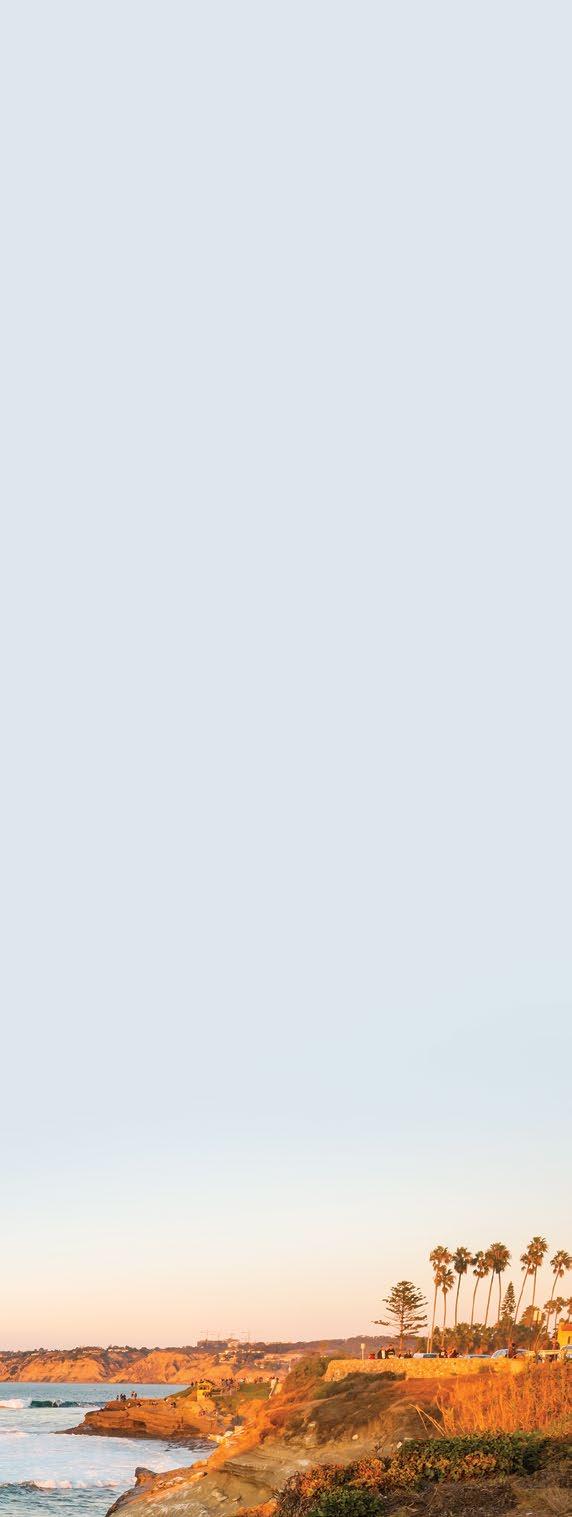


C: 305-613-4800 SSGAMEL@KW.COM www.LivingWellSanDiego.com D: 305-373-7000 alsoserving Rancho Santa Fe













Specializing in:
• Companionship
• In Home Support Services & Maintenance
• Meal Preparation
• Assistance with Activities of Daily Living
• Transportation Assistance
• Medication Administration Assistance
• After Surgery Care
• Respite and Relief for Caregivers
We pride ourselves in pairing the highest quality caregivers with our clients. Our care team will work with you to develop a client-specfic care plan, tailored to meet your needs.

Ruth Westheimer, Holocaust survivor who offered grandmotherly sex advice as ‘Dr. Ruth,’ dies at 96
by Andrew Silow-Carroll and Curt Schleier, JTA News
Ruth Westheimer, the diminutive Holocaust survivor and Israeli military veteran who charmed and educated millions of listeners as the taboo-breaking radio sex therapist
“Dr. Ruth,” died on July 12 at her home in Manhattan. She was 96.
Her program, “Sexually Speaking,’” which launched in 1980 on the now defunct WYNY-FM, broke broadcasting taboos about talking about sex and helped make her the
most famous sex therapist in the world — albeit one with a motherly demeanor and thick German accent.
She was a firm believer in sex as healthy dialogue among consenting partners, in which each indulged and appreciated the other’s needs and quirks. She also emphasized psychology over biology. “When it comes to sex, the most important six inches are the ones between the ears,” she once famously said.

by Luke Tress, JTA News
NYPD recruit Allan Pearlman was running laps in the gym in May during his training to become a police officer when he heard a loud thud behind him.
Pearlman, a Modern Orthodox Jew from Staten Island, turned around and saw one of his classmates lying on the ground, immobile.
Pearlman’s training as an EMT kicked in. He grabbed a police academy medical bag, rushed to his classmate’s side, made sure she had a pulse and treated her until an ambulance arrived.
by Ron Kampeas, JTA News
MILWAUKEE — Shabbos Kestenbaum remembers the first time he felt lonely because he held an unpopular political opinion.
The year was 2008, and Kestenbaum was 9 and a student at a Modern
Orthodox Jewish day school in the Riverdale section of the Bronx, where he lived. In a school journal, he decried the Iraq War and extolled a young senator running for president on a platform of opposing it.
“I remember with my dad, we bought a yard sign saying ‘Barack Obama’ in Hebrew,” Kestenbaum recalled in an interview on Wednesday afternoon. Soon, he recalled, a backlash began, at school and in synagogue.
Continue reading these stories at sdjewishjournal.com



Buy Judith’s new books, ‘The Lost Art of Dating’ & ‘Your Soul Mate Awaits’!
Judith’s thoughtful system is a fabulous guide, a must-read for every single!
DR. DIANA KIRSCHNER, Bestselling author of ‘Love in 90 Days’ Judith Gottesman, MSW
No one cares more about helping people than Judith.
GIL H. IN LA JOLLA
If I wouldn’t have contacted Judith, my life would be very different. I wanted to thank Judith for the time and persistence to find me the right person.
GIDEON S. IN SAN DIEGO
I would recommend using Judith’s services in a heartbeat!
NEAL L. IN SAN DIEGO
Read testimonials & buy her books at
All ages and backgrounds
by Andrea Simantov | andreasimantov@gmail.com
My Jerusalem home is located in the southernmost part of the city. Located between two Arab villages, one side of the apartment faces David’s Tower, the Western Wall, the entire Old City and, on an extremely clear day, the Dead Sea. The windows on the opposite side of the humble abode look upon one of Herod’s palaces called Herodian and Kibbutz Ramat Rachel. The six-story dwelling was built circa 1976 to provide affordable housing for civil servants, and is falling apart. Pipes are rusted and frequently back up, sections of the Jerusalem stone facade are in jeopardy, and the parking lot is pitted and buckled. The kitchen floor is uneven due to mysterious events occurring beneath the balatot tiles and I’ve been advised by several tradesmen that any attempt to change the floor will incur astronomical costs.
I love my home. A teenage granddaughter informed me that the style is considered “shabby chic,” and I can live with that. In fact, I believe that both my husband and I are the embodiment of “shabby chic” with an emphasis on “shabby.” Old books, thrift shop finds and solid wood furniture from another era furnish the main room and the fabulous maple dining table with two hidden drawers was an acquired gem from an Israeli secondhand site.
Our favorite corner in the house is the mirpeset (patio). Measuring only four feet by ten feet, we glassed

in the walls and added a second-hand ceiling fan for summer and heater for the winter. Within this precious space, we both start and end our days. Every morning — including the Sabbath — we celebrate sunrise with a steaming cup of coffee and discussion of, perhaps, the day ahead or things that are on our minds. Sleeping in is not an option unless, G-d forbid, one of us is ill. The day typically closes with a before-dinner beer, glass of wine or cold lemonade as we begin to unwind. This is the time of day when we attempt to shake off the dust of political unrest, difficult co-workers and anything to do with Hamas.
What makes this space so comforting are the plants. Through trial and error, I’ve learned to pot, prune and coax new roots from sprigs that have fallen off of vines. In addition to the colorful ivies and reliable spider plants, the patio
boasts a rubber tree, bougainvillea, an exploding avocado tree and crawling hot pepper shrub. At the time of this writing, three plastic bags with seeds wrapped in damp paper towels are hidden under the kitchen sink in an attempt to germinate a lychee pit, lemon seeds and a mango stone. (I’ll keep you posted.)
While I’ve always dreamed of having a small garden, I am coming to accept that I will, most likely, not acquire that imagined plot of land in this lifetime. Still, there is great satisfaction in creating a mini Eden in my tiny corner of the Holy Land, which emphasizes the partnership between us and our Creator. With a view of all that we hold precious, the majestic skyline of Jerusalem and, indeed, all of Israel sits just outside of my window, serving as an eternal reminder of His bounty and love. A

by T.S. McNeil tremcneil1980@gmail.com
It is a fact well known, if not always acknowledged, that if you want something done, ask a woman. From Mary Wollstonecraft laying down the groundwork of feminist theory in 1792 to Kate Sheppard making it so the women of New Zealand were the first to get the vote in 1893, some of the greatest movers and thinkers of the social and political spheres have been of the “gentle sex,” making things happen in their own gently persistent way. America has its own history of firebrands in corsets, some more remembered than others, including the author and economic equality activist Emma Lazarus among them.
Emma was born into relative privilege in New York in the summer of 1849. Her father, Moses Lazarus, was a respected sugar merchant. Her mother, Esther Norman, was no less impressive, descended from a well-established German-Jewish family at a time before antisemitisim hit a fever pitch in either America or Western Europe, and Jews were more likely to be part of the respectable business class. The LazarusNorman family boasted some of the first 23 Portuguese Jews in New York and an associate justice of the Supreme Court among their number.
Privately educated at home during a time when it was far from fashionable for girls to be taught to read, Lazarus read widely in terms of both British and the burgeoning American literary traditions and could speak several languages: English, Yiddish, German,
So great was her talent that... the “New York Evening Post” commissioned a collection of her poems.
French and Italian among them. Particularly fond of poetry, Lazarus wrote her first works of verse when she was only 11 years old.
Joining the ranks of war poets, Lazarus drew great inspiration from the American Civil War and New York’s uncomfortable place in it. Definitely northern and a non-slave state, there were heavy trade interests in the South, especially in terms of cotton, putting many New York merchants and politicians in a very awkward position. So great was her talent that William Cullen Bryant, then serving as editor at the New York Evening Post in addition to being a writer in his own right, commissioned a collection of her poems. Published in 1867, “Poems and
Translations” collected poems written when Lazarus was between the ages of 14 and 17, as well as translations into English of authors such as Heinrich Heine from German text and Victor Hugo from French text.
One of the greatest influences on Lazarus in terms of her work and her overall personality was Ralph Waldo Emerson, whom she thought to thank in her next collection of poems, “Admetus and Other Poems,” in 1871. The dedication read, “To my friend Ralph Waldo Emerson,” though it is unlikely that the two ever met. Her devotion to the dreamy abolitionist was possibly one of the first examples of a parasocial relationship.
Irrepressible and vaguely Byronic, Lazarus spent much of her twenties writing and publishing in reputable publications such as Lippincott’s Monthly Magazine and Scribner’s Monthly, kept afloat partly by family money. While taking the poetry world by storm and causing a minor sensation in Europe, Lazarus also found time to write her first novel, “Alide: An Episode of Goethe’s Life” in 1874, fictionalizing the true story of a love affair the future Faust author had as a young man with the daughter of a parson. It was followed two years later by “The Spagnoletto,” which was a tragedy without a wisp of romance.
Back to poetry with a vengeance by her early thirties and already living longer than either Keats or Shelley had,



For more infomation, call 858-720-8250 or visit https://www.msmfamilylaw.com/attorneys/myra-chack-fleischer/ Legal Experts with Humanity

Literature continued
Lazarus published “Poems and Ballads of Heinrich Heine,” a translation of what Lazarus deemed to be Heine’s best work, with a short biography of him at the beginning.
1882 also saw the publication of the article, “Was the Earl of Beaconsfield a Representative Jew?” in which Lazarus argues that he was, and, following the example of Grace Aguilar before her, doing more for the cause of the Jews at the time. The spark for her interest in the subject came in 1881 when she heard about the poor treatment of Jews in Russia following the assassination of Alexander II, prompting many to immigrate to America, most to New York.
An early champion of economic fairness, Lazarus also strongly supported the proposed reforms of the American political economist Henry George. Known generally as “Georgism,” the
proposal came down to a series of economic reforms that held both a capitalist and collectivist approach to ownership in which individuals could have private property in general, but land and natural resources to be shared equally. Considered slightly mad at the time, this is basically how it works in Scotland which does not have any legal standard for trespassing or private property in terms of land. Dwellings can be owned, but the land on which they are built is free to use.
As if she knew she was short on time, Lazarus visited Europe twice. Once in 1883 and in 1885, when the trip by ship was far from pleasant, staying on the second occasion for two years.
The poetry collection, “Poems in Prose,” the last work of her lifetime, was published in 1887, the year that she died at the age of 38, from what is now suspected of having been cancer. A

Growing up in the far north, Trevor James McNeil had little to do other than read when the temperature went below 40 Celsius, and he developed an affinity for stories of all sorts. Graduating from the University of Victoria in 2009, he has been reading and writing in a professional capacity since. He lives in a cabin in the woods with his dog, and firmly believes The Smiths would have been better as a trio.


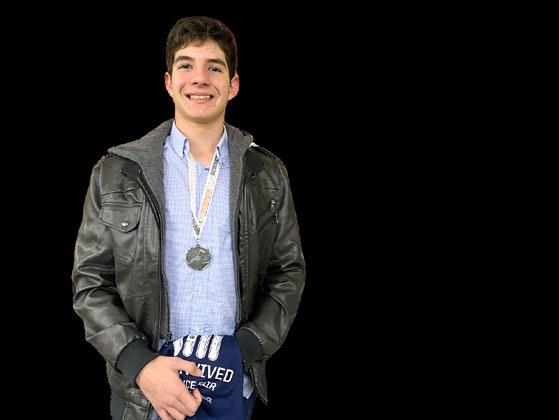
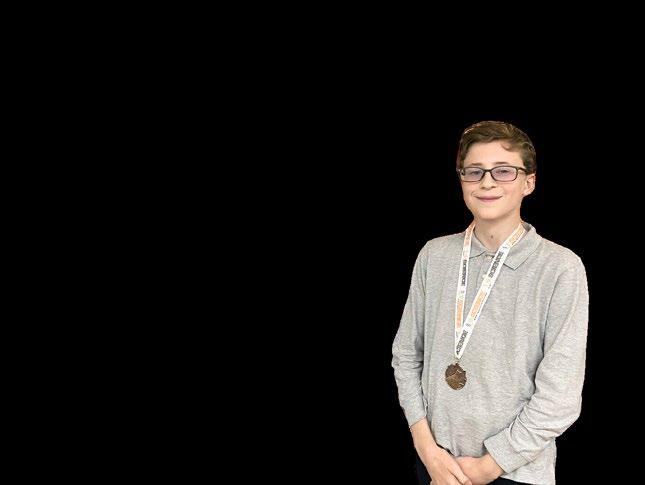




by Lisa McGuigan temeculatots@gmail.com
Paris Mulkey is on a mission, and, with the support of her community, she has embarked upon a grassroots initiative to include “Anne Frank: The Diary of a Young Girl” in Little Free Libraries across the United States. Recognizing the importance of Holocaust education in combating antisemitism, Mulkey’s project aims to ensure that the powerful narrative of Anne Frank reaches as many people as possible, fostering empathy, compassion and historical awareness.
Mulkey’s commitment to community service is deeply rooted in her family’s values. “I stumbled upon my neighborhood’s Little Free Library on a walk with my young son and took a look to see what people were reading; it was a lightning bolt!” Mulkey shared.
Understanding the crucial role education plays in eradicating ignorance and prejudice, Mulkey decided to take action. “Anne Frank: The Diary of a Young Girl,” or “The Diary of Anne Frank,” an intimate account of a young girl’s life during the Holocaust, seemed a perfect starting point.
“Every Jew knows ‘The Diary of Anne Frank.’ We read it voraciously in school, or perhaps on our own, and remember relating to this young girl who had the same thoughts and preteen feelings we had. We built a friendship in the attic and witnessed our friend fighting to survive the unthinkable. I remember hoping and praying she’d make it, despite knowing her tragic ending.”
[Paris understands] the crucial role education plays in eradicating ignorance and prejudice.
Mulkey’s initiative involves partnering with local communities, schools and organizations to distribute copies of “The Diary of a Young Girl” to Little Free Libraries nationwide. These libraries, often located in public parks, neighborhoods and schools, provide accessible reading material to people of all ages and backgrounds. By placing Anne Frank’s diary in these locations, Mulkey hopes to reach a diverse audience and inspire conversations about the Holocaust and the consequences of hatred.
Since its inception, Mulkey’s initiative has garnered significant support and positive feedback. Community leaders, educators and students have expressed
their appreciation for the opportunity to engage with Anne Frank’s story. Many have shared that reading the diary has profoundly impacted their perspectives on history and contemporary issues of discrimination and intolerance.
Mulkey’s ultimate goal is to have Anne Frank’s diary in every Little Free Library in the country, making it an integral part of community education.
“Success,” Mulkey shared, “depends on the collective effort of communities and individuals willing to support the cause.” Donations of books, participation in educational events and spreading awareness about the project are all crucial steps in ensuring its continued impact.
“If there’s a way to move the needle, even just a centimeter, we have to try. There’s space to be angry and sad and shocked or reclusive, but we have to do something. It can be as simple as buying a copy of Anne Frank’s book and placing it in a Little Free Library in your community. Help start the conversation. Help change the narrative.”
Paris Mulkey lives in the San Fernando Valley with her husband, Michael, and young son. She is an actor, activist and fitness professional. To learn more or get involved, contact Paris Mulkey at parismulkey@yahoo.com
Lisa McGuigan is an adventure-loving Jewish mama located in the Temecula Valley. She is also a co-founder of Jewish Together Temecula Valley, and creator of @temeculamama— a digital guide highlighting family-friendly fun in Southern California and beyond.


















JWV POST 385 — NORTH COUNTY “Boldest Post in the West”


• Fight anti-semitism
• Support our military overseas
• Comradeship

• Support Naval Hospital San Diego & Naval Hospital Camp Pendleton
• and much more...
CDR Marc Poland, USN Ret 858-232-1645
Meet 2nd Sunday of the month 11:00 AM Veterans Association North County (VANC) 1617 Mission Ave, Oceanside, CA 92058
JWV is the oldest congresssionally commissioned veterans organization in America
Michael Schwarz – San Diego
Ida Evendorff – Carlsbad
Carol Miller – La Jolla
Samuel Fajardo – San Marcos
Boris Borukhov – San Diego
Jonathan Sherr – La Jolla
Joan Jacobs – La Jolla
Joel Volsky – Vista
Sandra Greenblatt – Encinitas
Judy Glenn – Laguna Woods, CA
Selma Leigh – Rancho Santa Fe
Mark Liebergot – Houston, TX
Rhoda Froehlich – San Diego
Mercy Mandelbaum – Coronado

We Are San Diego’s ONLY All-Jewish Mortuary Serving the community for over 40 years.
✡ Proudly Serving Jewish Families For Over 40 Years.
✡ Family Owned and Operated for Three Generations.
✡ Serving all Jewish Families, Orthodox, Conservative, Reform.
✡ Affiliated or Unaffiliated with a Synagogue.
✡ We can assist with At-need or Pre-need funeral planning. Purchasing cemetery plots or burial arrangements anywhere.
✡ We are here to help, call or email with any questions.
6316 El Cajon Blvd., San Diego
Inna Aranson – San Diego
Norman Goldberg – San Diego
Ivan Boesky – La Jolla
Harriet Kruse – Escondido
Ruth Rohrlick – Encinitas
Stacey Miller – San Diego
Dorothy Omens – Cardiff by the Sea
Helene Weiner – Peoria, AZ
Richard Krantzman – San Diego
James Alan – Tempe, AZ
Beverly Berger – Encinitas
On behalf of AM Israel Mortuary, We extend our condolences to the families of all those who have recently passed. The families of those listed above would like to inform the community of their passing.
AM
We Are San Diego’s ONLY All-Jewish Mortuary Serving the community for over 40 years. (619)583-8850





by Susan Edelstein
There is an art studio in City Heights that has a huge and important mission — building a brighter future for children and young adults through pottery classes. These classes are offered at a low cost and free in a neighborhood with a large population of immigrant, refugee and economically disadvantaged kids. These children are often traumatized, depressed or anxious, and the emotional benefits that come from working with clay are widely known in the art therapy realm; Teralta Art provides its community with equitable access to this art form. Creating something from clay, from the potter’s wheel to the kiln, requires focus and care. The clay itself must be handled and manipulated with great care, and working on the wheel is a mind-body experience that requires focus and immersion. Working with this tactile element promotes mindfulness and emotional healing.
Teralta Art was founded in 2021 by Maggie Shen and Amanda Gardner, who believe that art-making is an integral part of human existence and
Working with this tactile element promotes mindfulness and emotional healing.
has been since ancient times, and that the opportunity for children to make art should exist in every San Diego neighborhood. Teralta Art’s studio “serves as a sanctuary, sheltering hearts in need, and as an outlet, allowing emotions to flow freely,” and since June 2021, more than 1,700 individuals have engaged in ceramics classes in their City Heights studio.
Regular access to a creative process provides children with a safe space and a positive emotional outlet, which fosters self-identification and self-expression. These children gain confidence and selfesteem when they produce something tangible that is unique to their feelings and experiences. Creating with clay also enables kids to show and honor their
culture. Engaging in their neighborhood studio helps build a sense of community and belonging in their environment.
Teralta Art’s Children’s Rights Projects have garnered the support of and partnership with organizations such as Urban Street Angels, which works to provide homeless youth ages 18-25 with creative expression opportunities to build confidence, the International Rescue Committee, which offers therapeutic art-making to families affected by war, and the National Conflict Resolution Center, which attempts to offer alternative solutions within the juvenile justice system. These connections bring so many people together to help engage our younger members in their community, build good citizens and empower them to see beyond today. Brighter futures are envisioned, and a way forward begins.
Teralta Art is a devoted group of responsible citizens whose “aspiration is to cultivate a virtuous cycle through art, a continuous positive loop that strengthens bonds and nurtures a thriving community spirit.” A

by Susan Edelstein
We all know how participating in acting classes can benefit children. They gain confidence and cultivate empathy while improving their communication skills and collaborative efforts. Theater connects children with history and fosters respect for different people, cultures and ideas. Perhaps the most important components are the fun to be had, the friendships that form and the emotional well-being that comes from feeling you are a welcomed member of a close-knit group.
Ben Cole has been the Director of The Theatre School @ North Coast Rep since 2012.
Ben holds a BFA in Acting/Directing as well as an MFA in Acting. He is also
a member of the Society of American Fight Directors and Dueling Arts International. He has acted, directed, taught and choreographed fight scenes all over the country. He has been an adjunct and visiting assistant professor at the college level, specializing in Shakespeare and stage combat, his two favorite things.
Ben has been involved professionally in theater for over 20 years, acting locally at The Old Globe, La Jolla Playhouse, North Coast Repertory Theatre and many others, and he has directed 30+ plays for The Theatre School @ North Coast Rep.
At TS@NCRT, Ben prioritizes nonmusical productions, small class sizes and small productions. His main focus
is for kids to feel welcomed, encouraged and part of a team. He promotes an open environment where self-confidence can grow. The school is student-centric to the point where the students can suggest plays they would like to see produced. Ben said that he “receives suggestions for classes and student productions all the time. I keep a list. While I ultimately try to offer options as diverse as possible, every now and then, I go to my list and find something that would be a perfect fit with what I’ve already planned. Sometimes, when students suggest something, we are able to offer it as a one-time workshop right away.”
Whether students plan to pursue a life in theater or not, they learn skills that build their confidence and foster
TS@NCRT’s 2022 annual summer touring Shakespeare production: “Much Ado About Nothing,” performed at
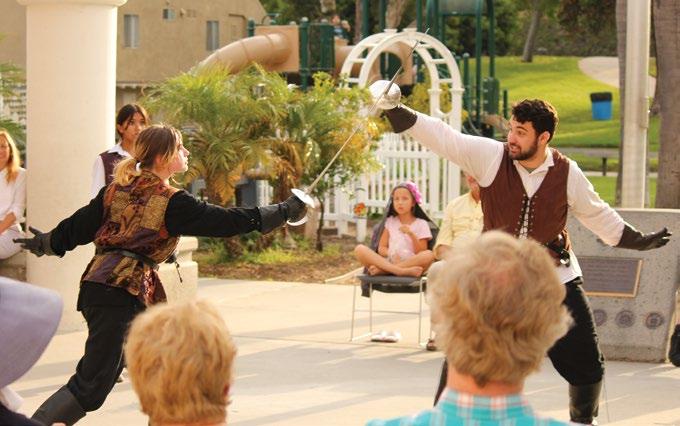
their creativity. They also gain a lifelong enthusiasm, appreciation and support for the arts. The Theatre School operates throughout the year with classes, workshops and summer camps and serves children ages 4-19. Ben strives for inclusivity through the availability of scholarships for economically challenged kids.
The Theatre School has grown from one production in its first season to six student productions annually, as well as one summer open-air, freeadmission touring Shakespeare play that reaches nearly 2,000 middle and high school students each year. This year’s production is “Hamlet,” opening at the Birdwing Open Air Classroom in Del Mar.
I asked Ben when and how he was first bitten by the acting bug. Well, when he was 12, Ben’s mom, who was a librarian at a local university, took him to a production of Shakespeare’s “Twelfth Night,” and that was it; he was hooked. After the show, they went to the book store and he bought, read and consumed all of Shakespeare’s plays.
When asked his favorite play of the Bard, Ben replied, “Of course ‘Twelfth Night’ is one of my favorite
Shakespeare comedies, having been the first Shakespeare show I ever experienced. Although ‘A Midsummer Night’s Dream’ is probably the one that comes up the most for me. I have been involved either as an actor, director or fight choreographer for over two dozen different productions of ‘A Midsummer Night’s Dream.’ ”
Perhaps the best anecdote to describe the nurturing environment Ben endeavors to create for the kids is when one of his students did not want to leave TS@NCRT and go back to his regular school after his theatre class because, “There, I’m just a weird kid, and here, I’m one of the group.” Dream on, you dreamers, and thrive. A
There, I’m just a weird kid, and here, I’m

by Susan Edelstein
San Diego Hebrew Day School is San Diego’s original full-day Jewish school established in 1963. This summer, SDHDS announced a new head of school, Rabbi Benjamin Geiger, who will be supported in this role by Rabbi Simcha Weiser, head of school for the last 43 years. A 3-year national search has brought Rabbi Geiger and his wife, Karen, from Los Angeles to San Diego Hebrew Day. Rabbi Geiger holds degrees in Talmudic law and computer science and, most recently, was general studies principal at Mesivta Birkas Yitzchok.
SDHDS’s Board Vice President Miriam Belsky notes that Rabbi Geiger is “a cherished educator, a genuine and caring human being, and an inspirational leader.” Rabbi Geiger’s range of expertise spans teaching high school physics, conducting character development workshops for adults, and leading an academic program of the highest standards of achievement and student support.
Rabbi Geiger states, “Every child should love learning and love Torah. A nourishing, loving school like Hebrew Day is the type of school that can partner with parents to help every child flourish. Karen and I are excited to join the San Diego community in this leadership capacity.” Welcome, Rabbi.
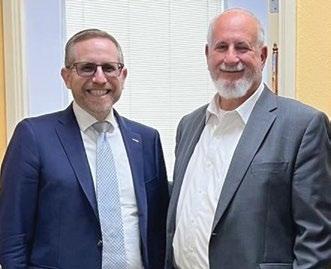

San Diego Jewish Academy has announced Shani Abed as the new head of the Golda Meir Lower School. Although new to this post, Ms. Abed is not new to SDJA. In fact, this will be her 27th year at SDJA. Through the years, she has been a classroom teacher, has occupied various administrative roles including dean of Golda Meir Lower School for 14 years, and for the last two years as director of school relations and community engagement. Ms. Abed was born and raised in Israel and moved to San Diego after her service in the Israel Defense Forces to attend UCSD where she earned a Bachelor of Science in Psychology and a Master’s in Counseling. Shani is married to Gill, and they have four children.
Shani’s devotion to SDJA is inspirational, and in her new role she remains committed “to implementing the school’s vision to create a dynamic and nurturing educational environment grounded in Jewish values. My goal is to foster strong academic excellence by promoting trust and respect among students, parents, teachers, and administration, and ensuring open communication and collaboration. In partnership with our parents, we will build a strong sense of community belonging and support our students to learn and grow to be confident learners and responsible citizens.” Congratulations, Ms. Abed. A

Hershey Felder Takes on Russian History in ‘Rachmaninoff and the Tsar’

by Makayla Hoppe
Acclaimed pianist and performer Hershey Felder will be delving into the world of the Russian Revolution with his newest production of “Rachmaninoff and the Tsar.” Hershey will perform the role of Sergei Rachmaninoff, while BritishItalian actor Jonathan Silvestri will play opposite him as Nicholas II. The San Diego Jewish Journal spoke with Hershey about the development of his newest production and how he made his unique form of performance into a career.
San Diego Jewish Journal: How long had you been working on telling Rachmaninoff’s story?
Hershey Felder: There was a plan to present this new play, albeit in a oneman format, in 2020. It was actually scheduled for San Diego Rep, among other locations, but with COVID and that terrible time, plans were put on hold. During COVID, I made a movie about the story that aired as one of the fundraising projects for arts organizations, including that theater. It was then it came to me that if I had the chance to do this on stage, it needed to be a two-person play, somewhat in the form of how I developed it for the film. The reason for this is inherent in the storytelling. Rachmaninoff was not really someone who spoke liberally to an audience in the way of a one-man show. He needed to be talking to someone. He had met the Tsar once in his life. That meeting stayed with him. It haunted him. This is that story.
SDJJ: How is it working with another actor for the first time?
HF: Well, it is not really the first time per se in terms of working with another actor. It is just that I am more known for the solo plays than I am for the work that I did before them. Then again, at least three-quarters of the films are with many actors in various ways. Audiences enjoy that, and for me, it is a wonderful thing.
It is a great challenge to have all the attention just on the one character. It is very nice to be able to share.
SDJJ: Did you hold auditions for the role of Nicholas II?
HF: Not in the traditional sense. Jonathan Silvestri is a very fine artist who played the role of Eugene Delacroix in my film about Chopin and Liszt — “Noble Genius.” He was marvelous in that role and an actor I very much wanted to work with again. It was largely due to that great experience that I was able to explore a two-hander for this new play.
SDJJ: How is this production different from other composers you’ve portrayed in the past?
HF: The obvious answer, of course, is that it is the first time that I am engaging with another artist on stage to tell this story. The story itself is quite different from any other characters, and with another actor, one has a different way of exploring the drama. Storytelling changes because in the one-man shows, the other “actor” is the audience, and the audience largely responds with laughter, silence or applause, but no words. This dynamic changes what one can do. Now we have three actors — Rachmaninoff, the Tsar and the audience.
SDJJ: Can you talk a little bit about the history of your career in general and how you made it into this profession?
HF: I began as a child actor on one side and a young pianist performing for the public — but never the two together until I was in my early twenties. I was mesmerized by the music of Chopin. I wanted to tell that in theatrical form. The famous director, Joel Zwick, whom I had met...said to me: “No one knows you, and Chopin is a classical but not popular character per se. Who is going to come? If you want to combine your disciplines, at least try something more familiar. Don’t you play the ‘Rhapsody in Blue?’ ” And so was born “George Gershwin Alone,” and apparently, so I am told, a cottage industry.
SDJJ: Is there anything else about your new show that you feel San Diego Jewish Journal Readers should know?
HF: Rachmaninoff lived at a time of pogroms in Russia. He lived at a time (that is albeit too familiar again) of great antisemitism. There is a large amount of evidence that he was extremely opposed to any antisemitic actions or behaviors and very supportive of Jews and the Jewish communities. His love of Horowitz, besides of the pianism, which would be a given, is one piece of evidence in such a complicated world. A

by Galia Miller Sprung
As an American, I’m sensitive to the strong emotions and associations caused by the mention of guns and border fences. As an Israeli, these words take me to a completely different experience and reality. In Israel, guns are for personal protection, and our border fences are meant to keep out terrorists.
When the enemy is the country next door, fences are an obvious necessity, even after peace treaties are signed. Although Israel signed a peace treaty with Jordan in 1994, over half of the 300-mile border separating the two countries lacks secure fences. Until October 7, this situation of rusty fences or, in some places, no fence at all was
not a major concern among the Israelis living along the border. However, the murderous Hamas attack on southern Israel destroyed their sense of security.
“I now have a gun,” said a mother of young children on one of the settlements.
“When there’s an alert, my husband goes to his position, and I’m home with the children. I need to be ready to protect my family.”
Her comment took me back to the 1970s when I lived on a moshav along that same border. I didn’t have a handgun then. I had an Uzi submachine gun issued by the Israeli army. Every woman on the moshav had one. A year earlier, I had graduated from UCLA and now an Uzi hung on my bedroom door
instead of a bathrobe. When the moshav had alerts because of suspected terrorist infiltrations from over the border, the men rushed to their positions carrying their M16 rifles or Kalashnikovs. We mothers were left home alone but armed. I can’t help imagining how differently the October 7 invasion could have ended if every woman there had had access to her own weapon. The army doesn’t issue weapons to settlement members anymore, only to their first response team members. Somewhere along the line, the idea of being prepared was lost to, dare I say it, arrogance — to a sense of invincibility.
When I worked in our fields back then, I took my baby and put her in a

When I worked in our fields back then, I took my baby and put her in a playpen at the end of a row of eggplants or tomatoes.

playpen at the end of a row of eggplants or tomatoes or green peppers. I then made my way up and down the rows, picking the ripe vegetables. I often looked across the border to the east, gazing at the purple mountains, wondering how the Jordanian farmers across the river were managing now that they, too, profited from our technology of drip irrigation and mini hot houses. The sun lit up the green leaves and the colorful array of winter vegetables that we had planted and harvested with our own hands. Surely, this was a mirror image of what was happening on the other side of the border. An invasion from across the border was not something we worried about. I did not take my Uzi with me.
When Hamas invaded on October 7, it became tragically clear that citizens who carried guns had a fighting chance to protect themselves and others against the terrorists. It’s no wonder
that attitudes and perceptions about the need for personal weapons have changed dramatically since that day. Over 300,000 civilians applied for gun licenses in the first months of the war. “We must be prepared,” said another woman whose settlement is along a stretch of border. “We aren’t living in constant fear, but we’ve learned the hard way that we need to be ready for anything. The relative sense of security we had before October 7 is gone.”
When I left that border moshav in 1980, my Uzi was returned to the moshav’s armory. Jump to 2002 and another move, this time to a new home in a community near Kfar Saba, at the edge of the Shomron-Samaria. As a resident of the Shomron, I was eligible to apply for a handgun. I did. This was during the Second Intifada with buses and restaurants blowing up and mass shootings at cars and cafes. Why didn’t I opt for a weapon like the army-issue
Uzi I had on the moshav? Israelis cannot buy submachine guns or rifles. Every Israeli civilian needs a license for a firearm, which means handguns of all sizes, weights, calibers and brands. Getting that license is a well-defined process open only to those who meet certain criteria, and only one handgun is allowed. Before I was issued my license, I had to provide signed approval forms from my doctor and the police. After the Firearm Licensing Department approved my application, I listened to a fourhour lecture about weapons and rules of engagement and received practical instruction. Only then was I allowed to fire a gun. After passing the five different shooting exercises, I was allowed to purchase a gun.
Eventually, I stopped carrying my gun and left it in the safe that is bolted to the wall. Although today I am not on the moshav, my daughters and their families are, and I can’t help wondering about those farmers on the other side that I used to think about while harvesting vegetables. Israeli reporters who crossed the border to interview Jordanians post-October 7 found their support for Hamas was clear. It’s a reality that we Israelis cannot ignore. The reality of the vulnerability of the southern border was ignored, and 1,200 men, women and children were savagely murdered, and 230 were taken captive to Gaza, where dozens have died.
I don’t know if my gun would help me if I were the target of an attack, but hopefully, I would be able to help others. I can hear your question: “Would you really shoot someone?” Someone? No. But a terrorist? Yes. A
Galia Miller Sprung moved to Israel from Palm Springs, California in1970 to become a pioneer farmer and was a founding member of a moshav in the Jordan Rift Valley. Today she is a retired high school teacher, a writer and editor. She lives with her husband in Tzufim.
by Zev Stub
Early in her senior year in high school in Washington D.C., Elie Ravitz-Basser realized that the Israel-Gaza war would upend her college plans.
“I applied to four universities in the United States early in the fall, but everything changed after October 7,” she said. “At that point, I decided to attend college only in Israel, surrounded by people who share my Jewish values.”
Ravitz-Basser is set to start her bachelor’s degree this fall in Jerusalem, pursuing a double major in English and liberal arts at Hebrew University’s Rothberg International School. She’ll be part of a brand-new, three-year undergraduate degree program, offered in English for the first time at Hebrew University.
“This is a unique opportunity to study in Jerusalem and immerse myself in the Israeli culture,” Ravitz-Basser said. “I’m excited about the classes I’ll be taking, and I feel a deep connection to my great-grandparents, who came to Israel from Poland in the 1920s with the vision of reestablishing their homeland.”
Ravitz-Basser is among many recent high school graduates who have reconsidered their college plans in light of the anti-Israel protests that swept across U.S. campuses this year. For her, the breaking point came during the violent protests and encampments that spread from coast to coast this spring, many of which were seen as not just antiZionist but antisemitic.
“That made it clear that I wouldn’t attend any college where I couldn’t feel safe without hiding my identity,” she said.
Hebrew University is not just a top-tier Israeli academic institution but also consistently ranks among the top 100 universities in the world. As it prepares to celebrate its 100th anniversary next year, the university has long offered a wide variety of programs in English for international students, including a one-year overseas program and about 40 different master’s programs.
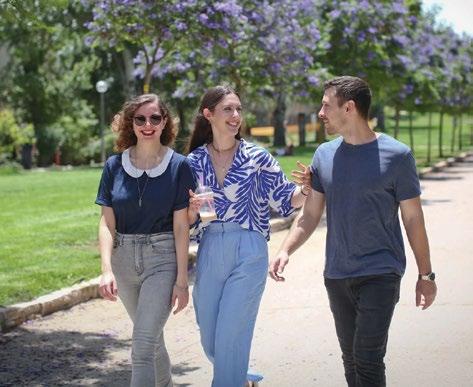
However, the new three-year undergraduate program in English marks the first time overseas students can complete an entire BA degree at the Jerusalem institution.
“The Rothberg International School has been developing this program for a few years,” said Naama Oryan, director of Hebrew University’s International Marketing Division. “Our original goal, which remains unchanged, was to offer a top-tier academic program that celebrates the diversity of Jerusalem and Israel. Students now have the option of studying for a BA in English at HUJI. We will support them and make HUJI their home away from home while they’re here.”
Degree tracks are available in English, business, and liberal arts, and all undergraduate students are required to pursue a double major.
“We offer it this way to encourage our students to engage in multidisciplinary learning,” Oryan said.
About 25-30 students are expected in the first year, primarily from North America but also from Japan, India, France, and Germany. Additionally, some new immigrants to Israel who prefer to take classes in English will join. Classes begin in November, right after the Jewish holiday season.
Unlike other programs, students have the option to transfer their credits from the English program to the university’s regular Hebrew tracks in their second year, allowing them to better integrate Hebrew classes as their language skills improve. Additionally, they have the option to take Hebrew classes to further enhance their language proficiency.
The tuition cost is one of the program’s biggest selling points. The undergraduate program costs $15,000 per year — a fraction of the price of most U.S. colleges. Master’s degrees typically range from $5,000 to $10,000 per year.
After securing scholarships for U.S. students, RavitzBasser expects to pay about $7,000 for her tuition in the program.
“Many of the US colleges I applied to were around $85,000 a year,” she said. “That’s amazing.”
These scholarships are made possible in part through American Friends of the Hebrew University (AFHU), the university’s American fundraising and promotional affiliate, which raises an average of $60 million annually to support Hebrew University. AFHU operates six offices across the United States and promotes the university through donor events and public relations efforts.
Hebrew University accommodates a diverse student body of 25,000 across six campuses in Israel, including three in Jerusalem and one in Rehovot. Approximately 10% of its students hail from overseas, representing over 90 countries worldwide.
Beyond academics, campus life at Hebrew University offers robust student support services and a wide range of extracurricular activities, from yoga classes and Shabbat programs to parties and Jewish learning opportunities. “Our office of student life has significantly expanded its services in recent years, now providing 24/7 support for nearly all student needs to ensure they feel cared for and at home” Oryan said.
The university campus serves as a vibrant hub where students encounter Israel’s diverse population, encompassing Jews, Muslims, Christians, and Druze. Despite political tensions, relationships between Jewish and Arab students have remained peaceful throughout the war. Approximately 20% of the university’s student body consists of Christian and Muslim Arabs, reflecting their proportional representation in Israel’s population.
Applications for the upcoming school year are still being accepted, and remaining spots will be filled on a first-come, first-served basis.
Interested students can find more information or attend an online open-house event at www.studyinjerusalem.com.
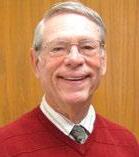




by Rabbi Yeruchem Eilfort
The evening of Monday, August 12 through Wednesday, August 14 coincides with the Ninth of the Hebrew month of Av, also called Menachem Av. In Hebrew, it is called Tisha B’Av. It is well known around the Jewish world that Tisha B’Av is the saddest day on the Jewish calendar, as several calamities befell our people throughout the centuries on this day. It was the day that the spies returned from the mission to determine how best to conquer the Land of Israel from its Canaanite inhabitants. Regrettably, the spies were intimidated by the Canaanites and counseled the Children of Israel to turn their backs on Israel, which led to the decree that meant the death of that generation of men between 20 and 60 years old in the desert. It was also the day in the years 422 BCE and 68 CE that the first and second Temples were
We have the mandate, and therefore the ability, to bring light to even the darkest places.
destroyed, respectively. Later, it was on this infamous date that the Spanish Inquisition officially began. Later still, it was on Tisha B’Av that the events that led to World War I, which led directly to WWII and the Holocaust, occurred.
Many of us have become comfortable in the Exile that the 9th of Av represents. We tend to forget that we
are not in the ideal situation for our people. We are blessed to live in a free country, and Israel is strong despite the best efforts of the haters in the world. Few of us are starving or homeless, thank G-d. We enjoy a good relationship with the politicians of both parties and law enforcement. We are doing well financially and are in prominent positions in the professional world. And yet a closer look at what is happening around the world tells a decidedly different story and should act as a reminder of how we are more akin to a “fish out of water” than is comfortable.
Just today, I heard reports that Jews who are defending themselves from organized riots and physical attacks in the heart of the Jewish community are being called vigilantes. Our enemies promulgate lies of the most obscene variety as they continually seek to
The seeds of redemption were planted with the destruction of the Temple.
delegitimize Israel. As they libel Israel and its supporters, they accuse us of doing precisely what they themselves do. They are the ones supporting the genocide of our people. They accuse us of Islamophobia as they immerse themselves in antisemitism. Ironically, they promote the most backwards of all governments and pseudogovernments while spreading their lies about a robust democracy. Incredibly, many wellmeaning people buy into the false narrative, including the big lie that Israel was founded by colonialists. No, my friends, we are in a deep and dark exile. The fact that many Jews do not even realize it makes it that much deeper and darker.
Guess what? There is a positive to all of this. The Talmud tells us that Moshiach, the human being descended from King David, who will inspire humanity to embrace G-d and who will reveal that G-d is truly everywhere and available to all, was “born on Tisha B’Av.” This means that the seeds of redemption were planted with the destruction of the Temple. Remember, a seed does not grow until its shell disintegrates.
The Creator built an interesting and counter-intuitive method of bringing redemption to the world. First the Jews must be exiled, and then the redemption can occur. But why is exile necessary? Exile, which entails the spreading of the Jewish people far and wide, allows/compels the Jewish people to spread the awareness of the One G-d to the four corners of the world.
Have we completed our job? Apparently, we have not yet fulfilled our mission as we sit here still in the Diaspora. But we know that we are close. There is a greater availability of Torah knowledge to all of humanity than at any other period of history, including but not limited to when King Solomon’s empire was at its zenith. What we have to come to understand is that through our people going through their trials and travails, we learn and we grow. We are becoming the giants we are meant to be. However, we cannot afford to let up even for a moment. On the contrary, we must double and redouble our efforts to bring the knowledge of the One G-d to every corner of the world.
The light that we will produce will not only drive away the darkness of our mortal enemies, but it will inspire all of humanity to reach its full potential. We have the mandate, and therefore the ability, to bring light to even the darkest places. We just have to decide to do it. That’s right, just do it! A

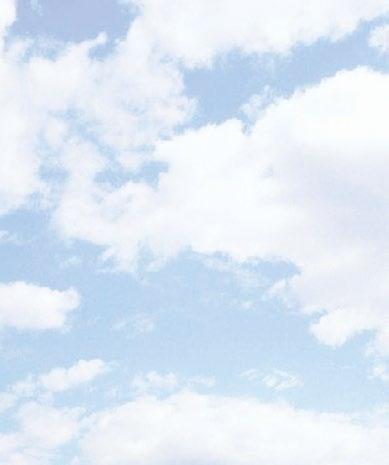
Larry M. Katz
858.461.0115
lkatz@lkatzcpa.com
www.lkatzcpa.com
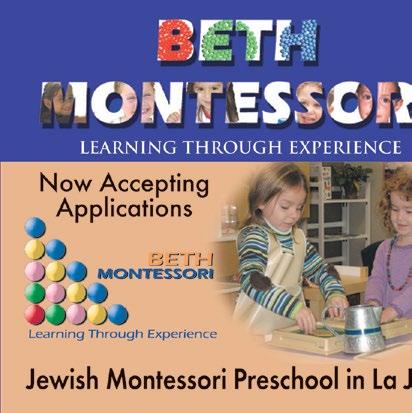
Children ages 9 months to 6 years

Proven Montessori Method and Philosophy
Bilingual Program: English & Spanish
Learning through hands-on experience
Integrated secular and Judaic curriculum
Skilled teachers, trained in early childhood development
Secured, state-of-the-art facilities

BY EILEEN SONDAK

northcoastrep.org
North Coast Repertory Theatre is showcasing an old favorite, “Don’t Dress for Dinner.” This contemporary take on a classic French farce will keep audiences in stitches with sexy hijinks, mistaken identities, and general mayhem through August 18
lambsplayers.org
The Lamb’s Players is showcasing “The 25th Annual Putnam County Spelling Bee” through August 18. The delightful piece delivers laughs by way of a grade school competition. The multi-award-winning show (performed by adults) is one of the funniest musicals around, and the Lamb’s cast is right on point.
theoldglobe.org
The Globe’s intimate theater is featuring “Ms. Holmes & Ms. Watson – Apt. 2B,” a fascinating reimagining of the most iconic sleuths in literature. This new high-energy play will delight audiences through August 18
The Globe’s outdoor theater is in full swing with a landmark adaptation of Shakespeare’s epic history plays. Adapted by the Globe’s own Barry Edelstein, “Henry 6” distinguishes the Globe as only the 11th theater in the nation’s history to complete the Bard’s canon with the largest Shakespeare production the Tony Award-winning theater has ever produced. The twopart staging of this must-see saga will take over the Festival Stage through September 15, with a sprawling cast and a top-notch design team bringing it all to life.


OLD GLOBE: “Ms. Holmes & Ms. Watson” playwright Kate Hamill and director James Vasquez.
HAMILL PHOTO: Suburban-Photography. VASQUEZ PHOTO: Mark Anthony Holmes.
lajollaplayhouse.org
La Jolla Playhouse is presenting the world premiere of “Derecho,” a play dealing with tensions between two sisters that boil over on a stormy night. This new dramatic work demonstrates how Latino values conflict with America’s ever-changing definition of success. “Derecho,” ensconced at the Forum Theater, will run through August 18. It is the 11th piece to have its world premiere at the Playhouse after development during the New Work Series. That’s quite an achievement!
The Playhouse is ready to unveil “Velour: A Drag Spectacular” (a co-production with Tectonic
Theater Project) on August 13. This groundbreaking theatrical offering has been a sell-out around the world, and Moises Kaufman’s staging creates a pop-art world of high camp that promises to be great fun. The show will take over the Potiker Theater through September 8
aquarium.ucsd.edu
Birch Aquarium is featuring “Hold Fast,” an immersive exhibition that explores local kelp forests and climate change through the lens of three local scientists and artists. “Hold Fast” will remain at the Birch through September.


LJMS: SummerFest’s “Notes on a Scandal.”
theconrad.org
The La Jolla Music Society’s SummerFest – with music director Inon Barnatan at the helm – continues through August 24. August 9 brings “Gratitude,” and the performance on August 11 is dubbed “In Loving Memory.” The series moves forward with “Notes on a Scandal” August 14 (another Midweek Masterwork) and “Synergy Initiative: Jazz @ The Jai Dan Tepfer, Natural Machines” entertains for two performances on August 15. A world premiere, “Synergy Initiative: Counterpoint II,” is on tap for August 16. “California Dreamin’” takes over on August 17, and look for “Instrumental Stories” (another Midweek Masterwork) for August 21. “The Road to Victory” comes along on August 23, and “The Finale, A Song and Dance” will wind things up for SummerFest on August 24

by Jacob Gurvis, JTA News
The 2024 Summer Olympics in Paris are around the corner, running from July 26 through Aug. 11, and dozens of Jewish athletes will be among the estimated 10,500 competitors representing roughly 200 countries in 329 events across 32 sports. The United States’ delegation features nearly 600 athletes, while Israel will have nearly 90 competitors, one of its biggest delegations ever.
There are veterans like an Australian gold medalist canoe paddler and Israel’s powerhouse judo team.
There are newcomers, like the youngest American female wrestler ever and Israel’s soccer team.
And there are athletes competing in events from fencing to beach volleyball to racewalking to air pistol shooting. Here’s just a taste of our full Olympics preview:
Claire Weinstein is only 17, but she’s primed for a breakout with the U.S. swim team, where she’ll compete in the 200meter and the 4x200m relay.
Artem Dolgopyat, who won a gold medal in the floor exercise at the Tokyo Olympics, returns as Israel’s only active gold medalist. And Israel’s rhythmic gymnastics team heads to Paris with high expectations; the team is coming
off its first-ever gold medals at the 2023 Rhythmic Gymnastics World Championships.
Nick Itkin, the No. 2-ranked men’s foil fencer in the world, headlines a strong group of Jewish fencers competing for both the United States and Israel.
Jessica Fox, regarded as the best paddler of all time, is back for her fourth Olympics. She’s won four medals, including a gold, and is joined this time by her younger sister Noemi. A
Jacob Gurvis is a contributing writer for JTA and SDJJ.

by Micah Siva noshwithmicah.com
Summer is coming to a close, but that doesn’t mean I’m ready to give up on no-cook meals that are perfect on a dinner table, lunchbox or in your picnic basket. I’ve always been a pickle fiend — in my household, pickles are their own food group, and I’m always looking for ways to add pickles to my dishes — and not just the pickle itself, but the brine as well! From adding a zing to soups, a different take on a martini, or marinade for chicken, don’t throw out your pickle brine! This salad gets better the longer it sits, as the brine will help season and soften the broccoli and cauliflower for a more tender salad. Add a can of chickpeas for a little protein, or top with grilled fish or chicken!
SERVES 4-6
INGREDIENTS:
• 1 head broccoli, finely chopped
• ½ small head cauliflower, finely chopped
• 1 cup chopped dill pickles
• ¼ cup fresh chopped dill
• 3 green onions, chopped
• ⅓ cup pickle brine
• ¼ cup tahini
• 2 tbsp. sweet relish
• 1 clove garlic, finely chopped
• 2 tbsp. sesame seeds
PREPARATION:
1. In a large bowl, combine the broccoli, cauliflower, dill pickles, dill, and green onions.
2. In a medium jar or bowl, combine the pickle brine, tahini, relish, and garlic, shake or whisk until smooth.
3. Pour the dressing over the broccoli mixture and toss to combine. Sprinkle with sesame seeds.
4. Enjoy!
by Marnie Macauley marniemacauley@gmail.com
My Dear San Diegans, I found the magazine’s theme this month unsettling. After writing about education for years, I could have looked at methods, teacher training, programs such as “No Child Left Behind,” school violence, or issues such as whether should schools give out condoms along with lockers in gym.
But I couldn’t. The big question that kept rolling around in my mulching brain is: do we need schools today, and if so, what do we need them to do? For this huge topic I have a universal question: has school become an anachronism? Before this high-toned theme scares us into enrolling in night school to study the philosophy of education throughout history, this is just a question, but to me, a critical one.
When mom first took my hand and led me into a massive, concrete, prewar building that bore a strange resemblance to a mental institution, I questioned this new situation then, but for different reasons. Little did I know that this “system,” starting with walking twofile, counting blocks, teachers yelling “People! People!” the belief the system was always correct, learning the Pledge of Allegiance with G-d in it, was designed to play a huge part in our growth, knowledge, fitness and yes, even our values, e.g. I love America patriotism. I believed firmly in liberty and justice for all people who, it was presumed, are
How can schools possibly compete with the deliberate effect of dominating thinking in the name of free speech?
created equal and entitled to pursue happiness. These were our rubricks. Although constitutional and moral precepts were hailed as our fundamental foundation, we shortly learned it just wasn’t so. We held wildly different definitions, explanations and excuses for adherence or not to ideals, say, of equality. In came the 1960s and the Boomers emerged angry and aggressive about making meanings real for the disenfranchised, the negatively labeled, the groups who, whether by law or custom, were treated unfairly, even dangerously.
The sphere of influence on our fragile young minds was changing.
When “Howdy Doody” was number one, the circle of dominant influence was family, religion and school. Despite vivid changes in music, tastes and censorship, in the ‘60s, it was still family, religion and school. Our questions about the mismatch between our ideals and the reality for Blacks, Jews and others, as well as values that were shifting toward a me-me mercenary theme, were still largely fought among ourselves even as we protested. Simply put, moms, dads, kids and teachers, while disagreeing with differing thinking, at least understood the vocabulary, language and basics.
This is no longer true. I, for one, no longer understand the world, even fundamentally, the language, the tech, the values. I don’t know what is a cloud beyond cumulus, a crypto, a ram vs. a rom, and on and on with each changing faster than the plastic jobs on the housewives of Beverly Hills.
If we’ve lost the basics, then we must look at school and the dramatic changes within that sphere of influence. School is now a vast distance from its traditional role. Like the giant maw of a hungry whale, the internet and its millions of codes for virtually all we know in the universe has taken over all aspects of life. By age three, the average child can master the new basics and lingo easily through clicking buttons. There are tutorials, many without an ounce of truth, “teaching” them science, math,
Advice continued
English. History can be from the point of view of Harvard the school or Harvey the schlemiel. On the “values” level, parents and houses of worship have been devalued in the face of this monster that overwhelms with literally billions of opinions and sureties even more mature minds simply cannot keep up with. How can schools possibly compete with the deliberate effect of dominating thinking in the name of free speech?
Only a few generations ago, Marshall McLuhan was concerned about the effect of television on society and young minds, and we still don’t know precisely. But we do know that the internet, with all its potential good, also has endless power to persuade, confuse and destroy, and has quickly replaced other sources, including real life, with too many ignorant, dangerous, manipulative, self-serving sources. The strong “come
hither” tease that pushes our most selfsabotaging addictive tendencies is being encouraged and is not subject to planned obsolescence. Divisiveness, confused principles, lost people and the acting out of these “values” (lack of empathy, devaluing of human life) are being taught and mirrored. School shootings are but one example.
So this maw is a monstrous tease that has taken over and is primed now with AI to supply most of our values from this day forward and will continue as long as it feeds those who have leverage and money. Moreover, the lightning speed of these changes damages the young mind’s ability to process information. There’s no time to think. Reaction, impulse and quickening are all.
Change is good. I applaud change for the correct reasons with the correct strategies. The ability to eliminate

waste, quicken routine procedures and add correctly to our knowledge base are huge boons. I’m not a philosopher, but I do believe it is in our best interest to survive. With that as a goal, the answer to the universal question, how to keep our schools historically and chronologically relevant, is: teach the necessary values including peace, purpose, empathy, the ability to think, to take time to process, to dream and consider. And learning that while differing ideas are critical, they need not be at the expense of a common human unity regarding life’s basic principles. These are the requirements to truly keep us safe and free. A child can always learn to spell C-A-T from a whiteboard or the internet, but in the face of the monstrous machine, I believe more attention must be paid to decreasing the maw. A















• Brochures & Direct Mailers
• Product Packaging
• Presentation Folders
• Trade Show/Event Collateral
• Stationery Packages & More! Call us today for competitive pricing and the product you need with the service you deserve! Eye

Phone: 858.566.0866 ~ Email: info@streeterprinting.com

Join us on a journey of lifelong learning! Enroll in our Preschool & Infant/Toddler Center, Religious School, and Adult Education programs today! Ready to Embrace Jewish Education? BILL & SID RUBIN PRESCHOOL INFANT/TODDLER CENTER
Ages 3 months - 5 years
LEE & FRANK GOLDBERG FAMILY RELIGIOUS SCHOOL
Pre-Kindergarten - 12th Grade ADULT EDUCATION
We offer an extensive selection of classes; open to all!
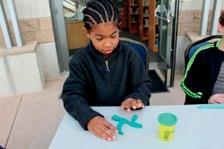

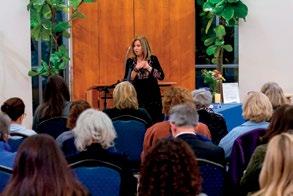


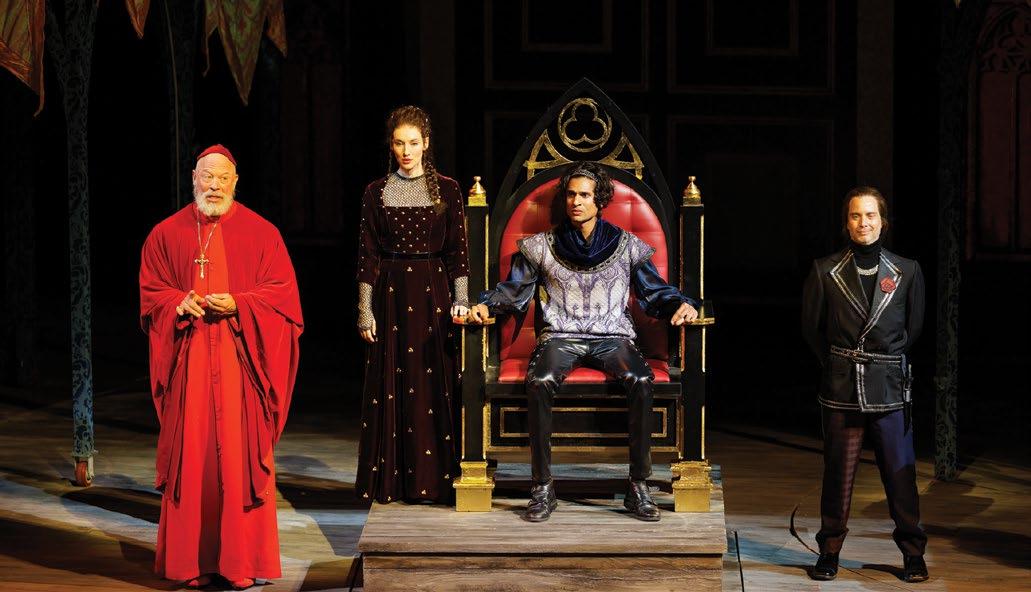





Sparkle on the field and under the bright lights of America’s Number One Ballpark at the Founders Gala in celebration of the University of San Diego’s 75th Anniversary.
us for a marvelous evening and step up to the plate in support of USD student scholars.
Marcos Shiley, Honorary Chair







